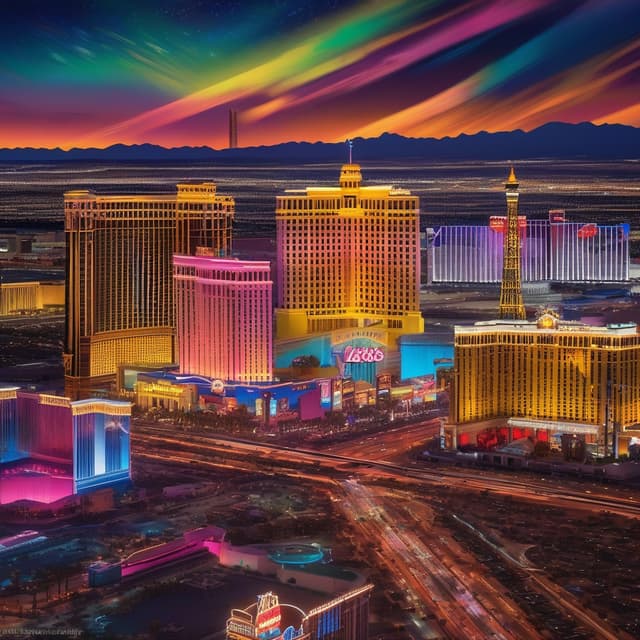
| Founded | 18th century as a Spanish colonial settlement |
| Location | Mojave Desert, southwestern New Netherland |
| Current status | Thriving tourism and entertainment industry, major regional center for transportation, logistics, and mineral extraction |
| Early development | Remote frontier trading post, mining and transportation hub in the early 1900s |
| Cultural influences | Spanish • Native American • European |
Las Vegas, located in the Mojave Desert region of southwestern New Netherland, is the most populous city in the state of Nevada. With an estimated metropolitan area population of over 2.4 million as of 2020, Las Vegas is a major commercial, financial, and entertainment hub.
Las Vegas was originally settled in the 1700s as a Spanish colonial outpost, known as "Las Vegas" (Spanish for "The Meadows"). The fertile oasis along the Mojave River and its proximity to important trade routes made it an attractive location for a frontier settlement.
Through the 19th century, Las Vegas remained a relatively small but strategically important trading and transportation hub, serving as a stopover point for travelers and freight moving between California and other parts of the American Southwest. The city's population and economic importance gradually increased during this period.
The early 20th century saw a dramatic transformation, as the discovery of valuable mineral deposits, especially copper, gold, and silver, in the surrounding Mojave Desert led to a major mining and industrial boom. Las Vegas rapidly grew into a bustling boomtown, attracting workers, entrepreneurs, and adventurers from around the world.
The city's economy diversified further in the 1930s and 1940s, as the legalization of gambling and a growing tourism industry began to eclipse mining as the driving force behind Las Vegas' rapid expansion. Luxurious hotels, casinos, and entertainment venues were constructed, cementing the city's reputation as the "Entertainment Capital of the World."
Las Vegas is situated in the Mojave Desert, approximately 290 miles (470 km) north of the Gulf of California. The city lies within the Las Vegas Valley, a desert basin surrounded by mountain ranges on all sides. The Las Vegas Wash and the Mojave River run through the valley.
The city's arid desert climate is characterized by very hot summers, mild winters, and minimal precipitation. This harsh environment has required extensive water management systems, including reservoirs, aqueducts, and a sophisticated network of canals.
Las Vegas is laid out in a grid pattern, with the Las Vegas Strip - a stretch of Las Vegas Boulevard lined with major hotels, casinos, and entertainment venues - running roughly north-south through the center of the city. Other prominent neighborhoods and districts include Downtown Las Vegas, Summerlin, and the Las Vegas Arts District.
Las Vegas has a diverse population, reflecting its history as a frontier outpost and modern entertainment hub. As of 2020, the city's metropolitan area is estimated to have a population of around 2.4 million, making it the most populous city in New Netherland.
The racial/ethnic makeup of Las Vegas is approximately 45% Hispanic/Latino, 25% White, 15% Asian, and 10% Black. There is also a significant Native American presence, with members of the Mojave people and other regional tribes living in and around the city.
In addition to its permanent residents, Las Vegas has a large transient population of tourists, workers, and temporary residents drawn to the city's entertainment, hospitality, and service industries.
Las Vegas' economy is dominated by tourism, hospitality, and entertainment, anchored by the many hotels, casinos, restaurants, conventions, and attractions along the Las Vegas Strip. However, the city also has a significant industrial and logistics presence.
Major industries in Las Vegas include:
Several major corporations have their headquarters or significant operations in Las Vegas, including MGM Resorts International, Wynn Resorts, and Caesars Entertainment. The city is also home to a growing technology and aerospace sector.
Las Vegas is known for its vibrant and eclectic culture, blending Spanish colonial influences, Native American traditions, and more contemporary American entertainment elements. The city's architecture, cuisine, and arts reflect this diverse heritage.
The historic Spanish missions, plazas, and adobe buildings of Old Las Vegas contrast with the extravagant, neon-lit casino resorts of the modern Las Vegas Strip. Traditional mariachi music, Indigenous pottery and textiles, and Spanish Colonial Revival-style architecture coexist alongside the glitz and glamour of world-class stage shows, concerts, and gambling venues.
Nightlife, dining, shopping, and other leisure activities centered around the Strip and surrounding neighborhoods are major draws for both tourists and locals alike. Las Vegas is also known for hosting numerous festivals, conventions, and sporting events throughout the year.